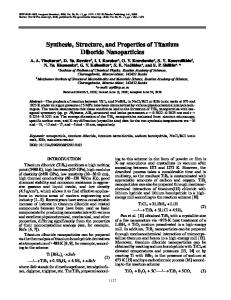Synthesis, Structure, and Spectroscopic Properties of Isotianil as a Bactericide
- PDF / 292,923 Bytes
- 5 Pages / 612 x 792 pts (letter) Page_size
- 1 Downloads / 360 Views
ynthesis, Structure, and Spectroscopic Properties of Isotianil as a Bactericide J. Zhanga, J. Jia, B. Wanga, A.-Q. Jiaa, and Q.-F. Zhanga,* a
Institute of Molecular Engineering and Applied Chemistry, Anhui University of Technology, Anhui, 243002 China *e-mail: [email protected] Received May 31, 2020; revised June 9, 2020; accepted June 25, 2020
Abstract—Isotianil [N-(2-cyanophenyl)-3,4-dichloro-1,2-thiazole-5-carboxamide] has been synthesized in a good yield with high purity by reaction of the key intermediate product, N-(2-carbamoylphenyl)-3,4-dichloro1,2-thiazole-5-carboxamide, with thionyl chloride in N,N-dimethylformamide at 60°C. The structure of isotianil was studied by X-ray analysis. It crystallized in triclinic space group P1‾ with a = 11.459(3), b = 12.632(3), c = 22.528(5) Å, α = 78.897(3), β = 81.730(3), γ = 71.493(3)°, Z = 10. Keywords: bactericide, isotianil, intermediate, organic synthesis, X-ray analysis
DOI: 10.1134/S107042802010022X INTRODUCTION Isotianil is an environmentally friendly bactericide that is used mainly for the prevention and control of rice blast by stimulating the natural defense mechanism of rice itself [1–4]. In 2002, Himmler reported a synthetic route to isotianil via a one-pot reaction starting from isatoic anhydride [5]. Treatment of isatoic anhydride with ammonia in the presence of N,N-dimethylformamide gave 2-aminobenzamide, which was directly reacted with 3,4-dichloro-1,2-thiazole-5-carbonyl chloride to obtain N-(2-carbamoylphenyl)-3,4dichloro-1,2-thiazole-5-carboxamide, and the latter was treated with thionyl chloride to afford the target isotianil. The reaction of 2-cyanobenzylamine with 3,4-dichloro-1,2-thiazole-5-carbonyl chloride in the presence of pyridine or 4-dimethylaminopyridine also afforded isotianil [3, 6]. However, the reported syntheses of isotianil have problems such as low yields along with low purity. Herein, we report a synthetic route to isotianil with high purity and high yield and its molecular structure according to single-crystal X-ray diffraction data. RESULTS AND DISCUSSION As shown in Scheme 1, the starting material was 3,4-dichloro-1,2-thiazole-5-carbonitrile which was converted to 3,4-dichloro-1,2-thiazole-5-carboxylic acid (1) in quantitative yield by hydrolysis in aqueous sodium hydroxide. Treatment of compound 1 with
thionyl chloride in DMF afforded intermediate 3,4-dichloro-1,2-thiazole-5-carbonyl chloride (2) which reacted with 2-aminobenzamide in DMF at 60°C to give the key intermediate product, N-(2-carbamoylphenyl)-3,4-dichloro-1,2-thiazole-5-carboxamide (3), in a good yield. The target isotianil (4) was readily obtained by treatment of 3 with thionyl chloride in DMF. In the 1H NMR spectrum of 3, the signal at δ 7.20–7.15 ppm was assigned to protons of the NH2 group, and signals in the region δ 7.52−8.26 ppm were attributed to aromatic protons. The 13C NMR spectrum of isotianil showed two signals at δ C 157.35 and 116.89 ppm due to C=O and C≡N carbons, respectively. In the 1H NMR spectrum of 4, the peaks in the range δ 7.49–7.92 ppm
Data Loading...











